CptCurl
|
| (.450 member) |
| 26/11/12 02:38 AM |

|
|
|
Quote:
. . .
The calibre is unusual, I would have expected .450/400 2/38 inch with considerable variation at this time, although I am sure you have checked thoroughly
TH44
I had planned to discuss my path to identifying the chamber when I add information about shooting the rifle in the coming week. Your skepticism sparks me to do it now. Believe me, I shared your skepticism, and even more. Let me take you along the path to discovery. Everyone please forgive me, because this will be a somewhat lengthy post.
BACKGROUND:
This rifle first came to my attention in September 2011 when I saw it listed for sale on the website of Safari Outfitters in New York. At that time I archived the photographs and the verbal description for my records. It was (wrongly) identified as a .450/.400 2-3/8" BPE.
Here are a few of the images from that ad, followed by an image of the verbal description. You can plainly see it is the same rifle (serial number even legible in 3rd photo):





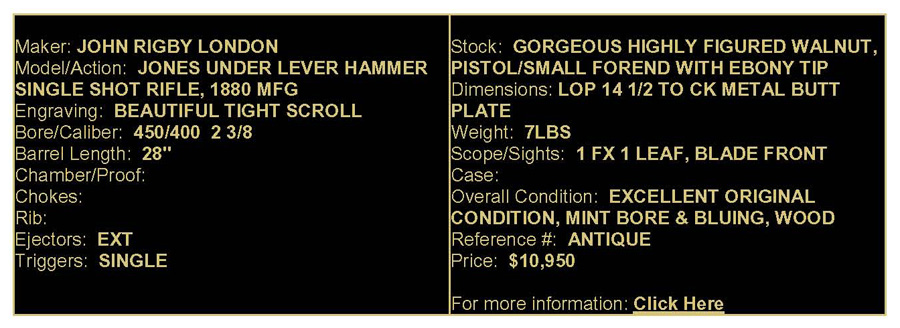
Although I was interested, I wasn't in a position to make an attempt on it at that time. The rifle didn't stay long on the Safari Outfitter's website. I suspect somebody was sorely disappointed upon trying to chamber a .450/.400 2-3/8" cartridge in its chamber.
THE JULIA AUCTION:
I next encountered this rifle listed in the James Julia, Inc. October 2012 auction (from whence it eventually came to me). There it was featured with a much more detailed verbal description and better quality photographs. The Julia photographs are the last seven photos of the rifle in my initial post.
Here is a partial quote of the verbal description:
Quote:
RIGBY TIP-DOWN SINGLE SHOT HAMMER RIFLE. SN 15130. (ca 1881) Cal. 10.15 x 63R. (Serbian Mauser)
This fine rifle in this unusual caliber, which was quite advanced for its day, being the 43 Mauser necked down to 40 caliber, has 28" slightly tapered, ovate bbl, top flat of which is file cut in front of one standing, one folding express rear sight and silver bead front, which is longitudinally dovetailed into soldered-on small ramp. Top flat behind rear sight, is engraved "John Rigby & Co Dublin & London" in Old English script. A sling eye is soldered to bottom of bbl. Breech area is stamped with London proofs, SN, and Rigby RR logo.
When I saw the Julia listing I recognized the rifle as the one I had seen a year earlier. I searched my records and found the photos and description I just posted above.
Malcolm MacGregor is the gent who writes descriptions for Julia's antique firearms. He is a respected authority and quite knowledgeable. So it certainly gained my attention that he identified this .400 rifle as a 10.15x63R Serbian Mauser.
Before the auction I spoke with Mr. MacGregor by phone to discuss this rifle at length. He assured me he was confident in his identification of the chamber and pointed to various dimensions in support of his opinion.
RESEARCH:
Based on that conversation, I set out to research the cartridge.
My first "view" of this strange Serbian military round came from Cartridges of the World:
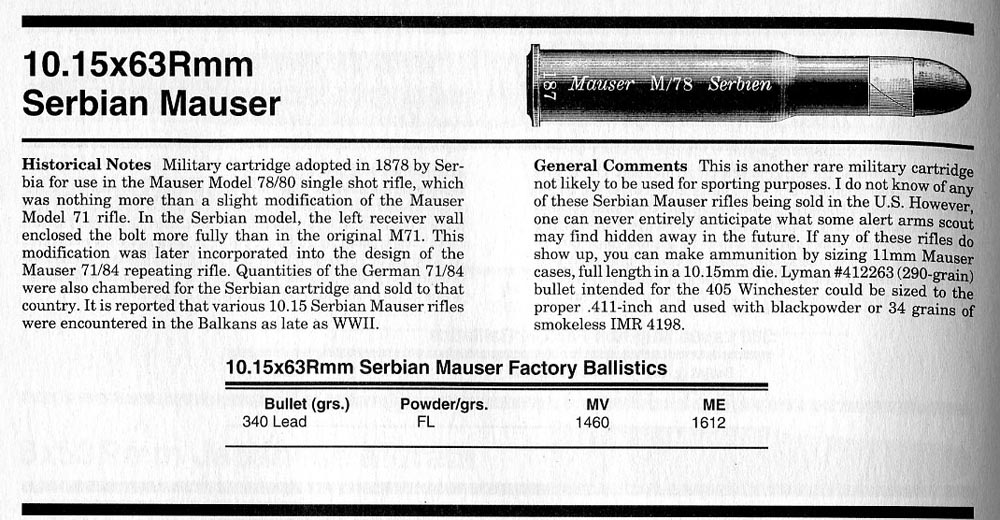
A Google search gave me some dimensional information for the 10.15x63R Serbian Mauser:
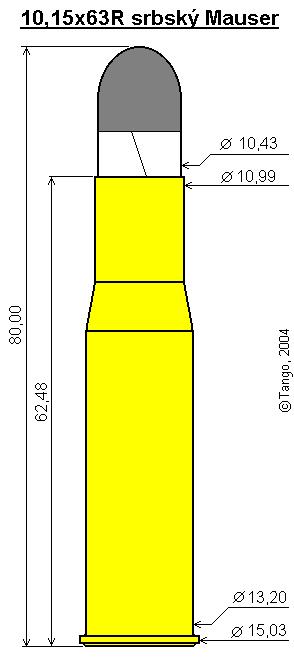
THE RIFLE IS MINE; HANDS-ON INVESTIGATION:
I bid on the rifle, and it became mine. Upon taking delivery the first task was to make a Cerrosafe cast of the chamber and first couple inches of the bore. You have seen this photo:
Here's where the mystery begins. The cast did confirm a groove diameter of .411", but as to all other matters, the cast only raised questions. The first big issue is case length. My cast measures 2-1/4" or 57mm:
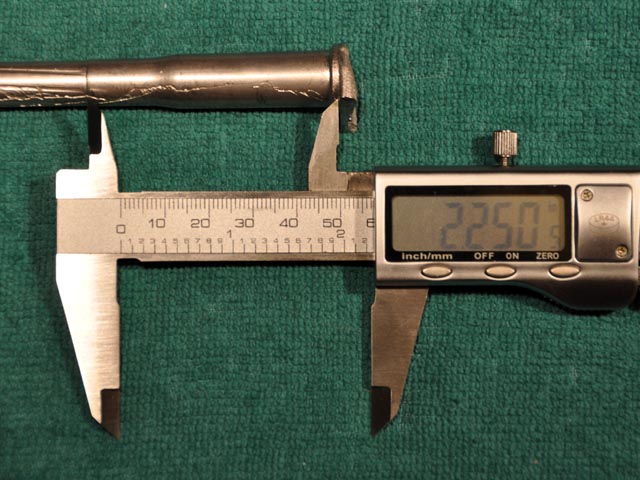
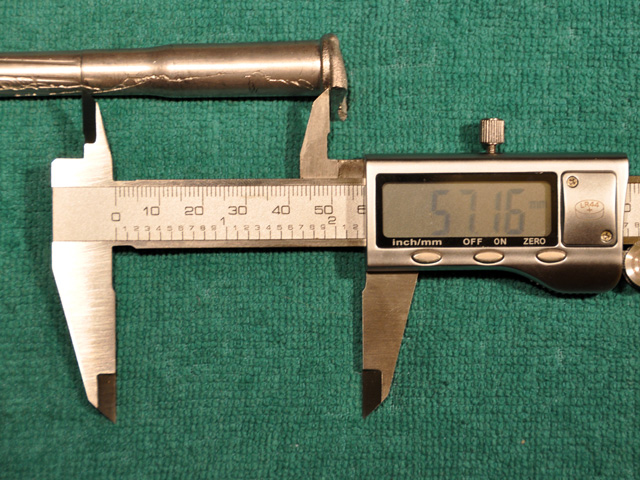
Well, right off the bat that rules out the Serbian Mauser round, with its case length of 62.48mm. But it also rules out the .450/.400 2-3/8" BPE. Both cases are clearly too long for this chamber; and besides, the head of the .450/.400 is all wrong.
MORE RESEARCH:
I went back to all the references I have. First I looked for a British cartridge consistent with my chamber cast. None was found. Next I looked for a European cartridge for a match. Nothing! My mind was fixated on English rounds because of the maker, but I was also fixated on European rounds because of Mal MacGregor.
Mal MacGregor opined that the cartridge could be formed from 11.15x60R Mauser brass (.43 Mauser). I got CIP dimensions for that round:
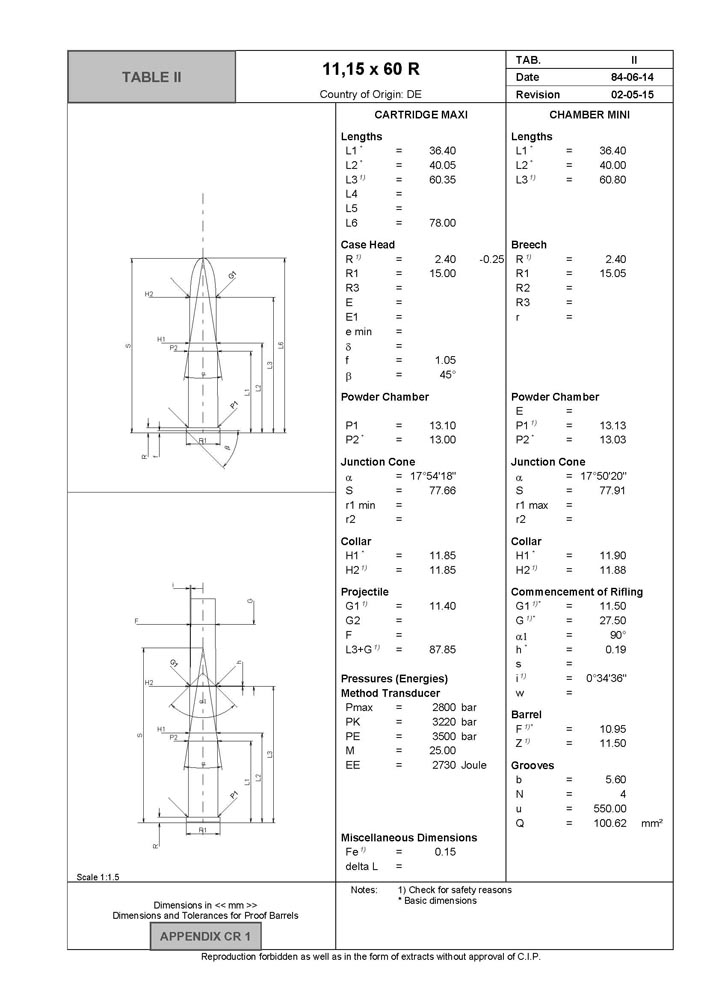
FORMING A CARTRIDGE:
I determined the dimensions of my cast, including rim diameter, head diameter, shoulder diameter, and length to shoulder were very similar, so I decided to try to make one or more cases from this round. I ordered 20 rounds of Bertram's .43 Mauser brass, which arrived in due course.
At this point I anticipated having a set of custom reloading dies made for the round, so my goal was to have one or two fired cases to submit with my chamber cast. Somehow I had to make a .43 Mauser case fit into this chamber.
I went through quite a few gyrations, using many of the various dies I have on hand:
1) Reduce the neck only in a .44-40 sizer;
2) Further reduce the neck only in a .303 Brit. sizer;
3) Reduce the neck still further in a .225 Winchester sizer;
4) Expand the neck using a .450/.400 NE expander;
5) Trim to length;
6) Reduce case body slightly using a .375 H&H sizer
In the end I had a shortened and necked .43 Mauser case that would slip in the chamber. BUT THE DAMN ACTION WOULDN'T QUITE CLOSE!
I discovered that the rim and head protrusion of Bertram's .43 Mauser brass is slightly thicker than the rim called for by my Rigby. It obviously wasn't much, but something needed to be done. I don't have a lathe to take material off the front of the rim, as should be done. So I decided to file the rear of the case head. After a few minutes of filing I had a case on which the rifle would close. Fortunately, the primer pocket was still deep enough to seat a primer flush.
Next I cobbled together a loaded round, using a cast bullet I reduced in size appropriately. I fired it into a dirt bank and had a fired case! I duplicated this effort and ended up with two fired cases.
Here's a lineup:
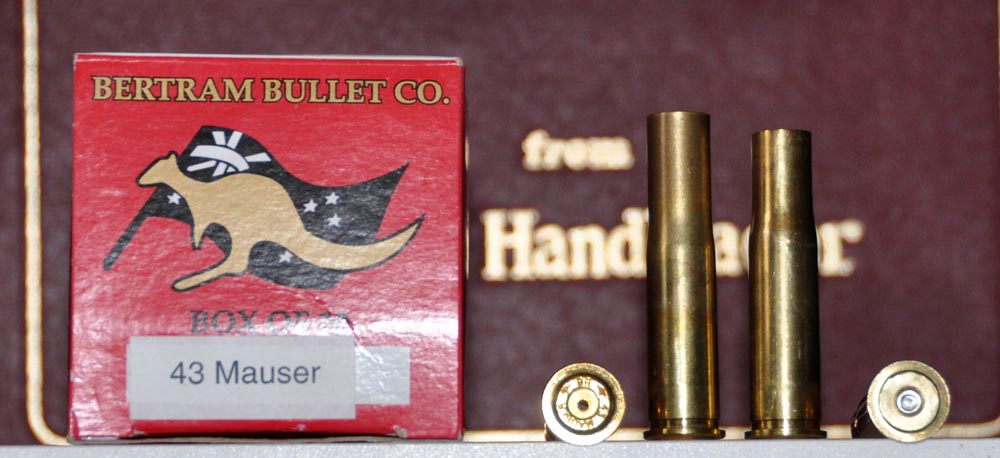
The cartridges, left to right:
1) Head of Bertram .43 Mauser case;
2) Un-altered Bertram .43 Mauser case;
3) My formed and fired case; and
4) The head of my formed and fired case (notice it is smooth from filing).
So at this point I know I can make brass to work, but I also know it takes a lot of time, effort, and expense. I still want to know what is this chamber!
EPIPHANY AND SALVATION:
Now networking comes to the rescue. I had been lightly corresponding with our member, Huvius, about this rifle and the cartridge mystery. At this point, having actually fired the rifle, I again expressed my profound inability to identify the cartridge and asked if he had any ideas. On November 8 he sent me a PM in which he said:
Quote:
One thought I had was considering the popularity of Rigbys in the US late in the 19th century, could it be possibly chambered for a .40cal American cartridge?
Looks similar to the 40/70 (Winchester or Rem. dont remember...)
There were a bunch of necked 40cal American cartridges back then.
Like I said, I had been fixated on English and European rounds. I hadn't even considered any American rounds. Immediately I pulled Cartridges of the World and found this entry:
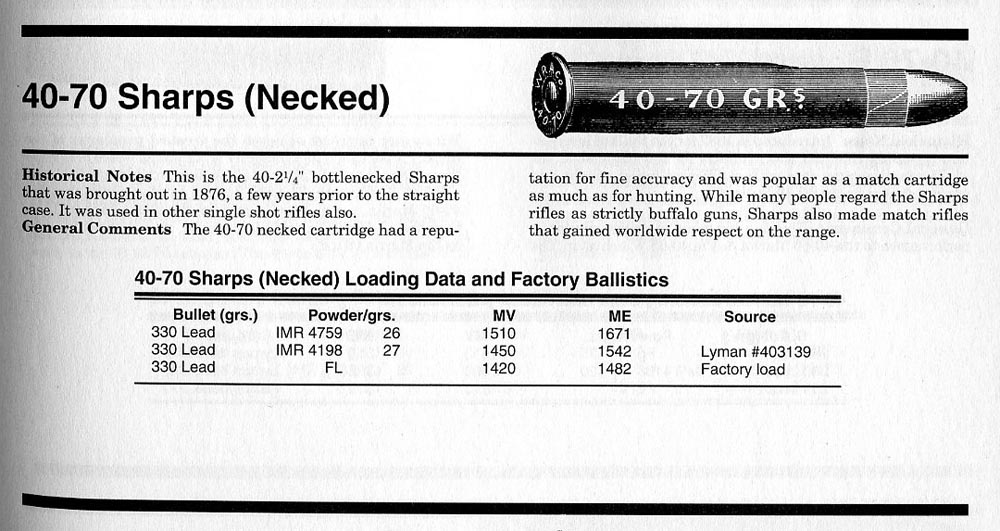
This source also lists approximate dimensions, and it looked like I had a match. So I started research for the 40-70 Sharps. I found nothing in the way of standard dimensions, but I did find that Buffalo Arms Co. listed RCBS dies and formed brass for it!
BUFFALO ARMS CO.:
I got Buffalo Arms Co. on the phone and explained my problem. The gent said, "We have a guy here named Seldon who researches these things. He's an expert. People send chamber casts and fired cartridges to him for identification." That afternoon my chamber cast and a fired cartridge were headed out to Sheldon. Several days later he called me and said without a doubt it is the .40-70 Sharps Bottle Neck. I ordered a set of dies and 60 rounds of brass, all of which arrived last Monday. The Buffalo cases are formed from Starline .45-90 cases and appear to be of fine quality.
You can't imagine my excitement when I compared the formed cases from Buffalo to my fire-formed cases. To the eye, an exact match! The Buffalo cases slip right into the chamber. The action closes smoothly and tight!
Here, you take a look and compare them:
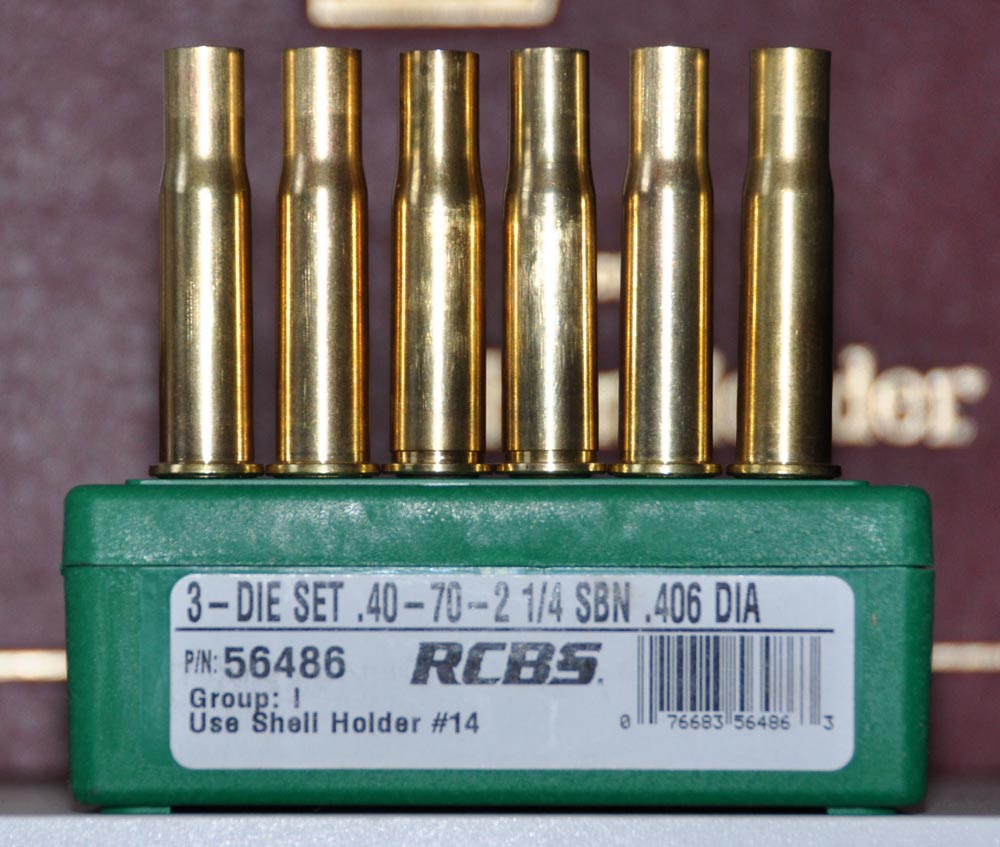
My two fired cases are in the center, flanked by two out-of-the-box Buffalo Arms Co. cases on each side, all standing on top of a glorious set of RCBS dies.
So at this point I have brass and dies, but I don't have any properly sized bullets. All the .40 caliber bullets in my inventory are .411". The chamber of this Sharps won't quite accept a bullet of that diameter. I have on order some swaged .399", 330 grains paper patch bullets from Buffalo which should be perfect and which should arrive in a day or so.
My next report will be after firing at the range! Huvius, thanks again!
WAKE UP, IT'S OVER! Thanks for your patience with this loooooong post.
Curl